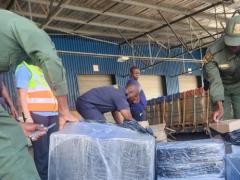Volatile yet unexpectedly strong – that is how 2025 has turned out for global air cargo, according to director general of The International Air Cargo Association (Tiaca), Glyn Hughes. The sector has spent much of the year navigating sharp policy swings from the 47th US presidential administration, whose shifting tariffs and trade positions have kept manufacturers and logistics operators “in a permanent state of readiness”. “Front-loading ahead of anticipated tariff hikes, many of which were later deferred, has created stop-start cargo flows throughout the year,” said Hughes. “The ending of the de minimis import exemption had an immediate and lasting impact. “We saw a 50% drop in e-commerce shipments from China into the US almost overnight and an almost immediate shift of volumes to Europe from China, which saw a near 100% increase in volumes.” Despite the turbulence, expanding intra-Asian trade, rising Asia–Latin America flows and improving global economic conditions have helped lift overall air cargo volumes in 2025. According to Hughes, the airfreight sector has been steadily correcting from the extraordinary Covid-era peaks. “The highs we saw during the Covid pandemic were unsustainable and, in fact, had they remained at that level would have been detrimental to long-term air cargo growth.” More realistic yields have restored air cargo affordability, enabling and facilitating growth across many regions. “The Red Sea crisis continues to have an impact, and maritime sailings from Asia to Europe remain excessively long and more costly than historical norms,” he told Freight News. “This has reduced the differential between air and ocean, further supporting air cargo volume growth. As noted earlier, e-commerce volumes fell on China–USA routes, leading to a consequential reduction on yields, though relatively minor as capacity shifted elsewhere, keeping load factors healthy. “By contrast, e-commerce into Latin America and Europe increased, driving significant increases in capacity and demand, with yields rising in line with the time- sensitive nature of the cargo.” As 2025 has progressed, Southeast Asia–USA trade has also strengthened, particularly from Vietnam as final assembly of high-tech items such as laptops has moved there to avoid higher Chinese tariffs. India has recorded similar momentum in smartphone production, becoming the largest exporter of these devices to the USA and supporting higher yields on that corridor. Hughes said against this backdrop, e-commerce had remained the clear standout, delivering double-digit increases and reinforcing its position as the sector’s dominant growth driver. Perishables, pharmaceuticals, semiconductors and high-tech cargo have also recorded gains, though at more moderate levels. “Throughout 2025, air cargo has demonstrated a significant ability to be agile and responsive to evolving market, policy and regulatory conditions,” said Hughes. “This flexibility in approach – to shift capacity to where it is needed, to introduce market-aligned solutions and to continually innovate – has facilitated over two years of consecutive month- on-month growth and places the industry in a strong position to meet future challenges.” LV












